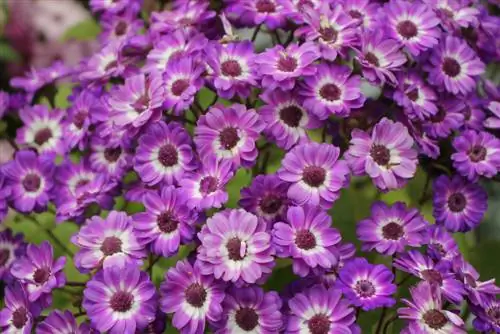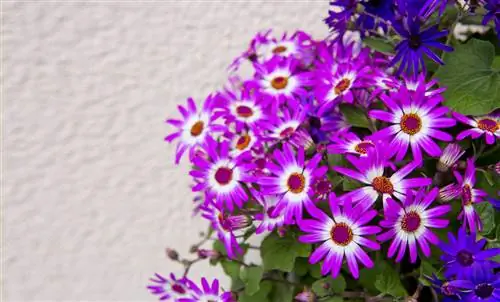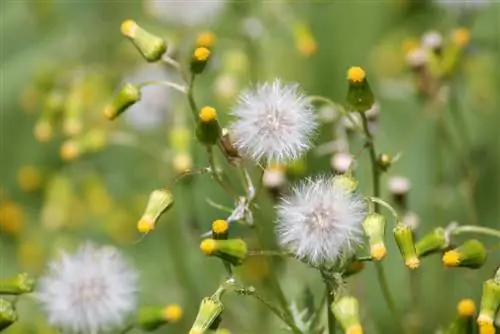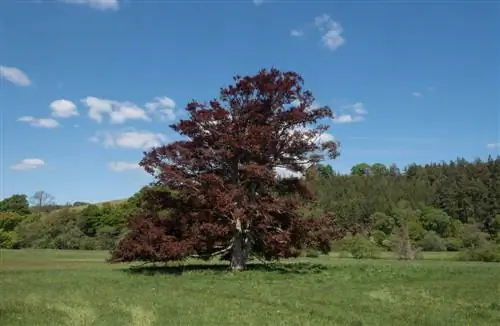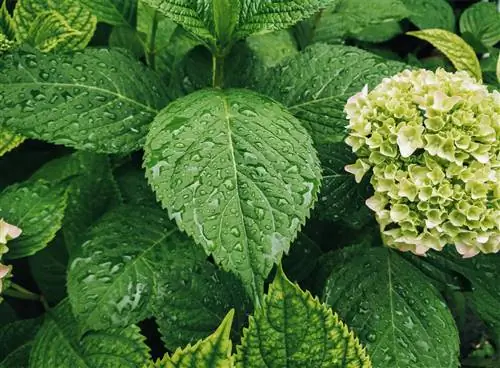- Author admin [email protected].
- Public 2023-12-16 16:46.
- Last modified 2025-06-01 06:02.
Read here in the commented ashflower profile information about growth, flower splendor and toxicity. Tried-and-tested tips explain how to properly plant and care for a lice flower.
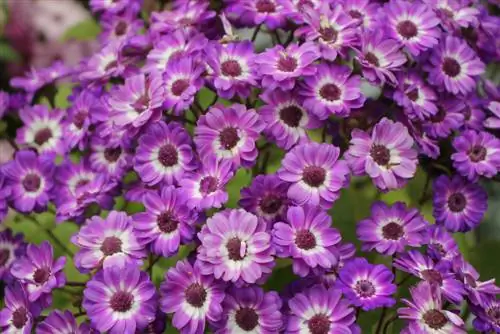
What is an ash flower?
The ash flower (Pericallis hybrida) is an annual, herbaceous plant with colorful, daisy-like flowers in white, blue, violet, red, pink or purple. It comes from the Canary Islands, is easy to care for and blooms from February to May and August to September.
Profile
- Scientific name: Pericallis hybrida
- Family: Compositae(Asteraceae)
- Synonyms: lice flower, garden cineraria, cineraria
- Origin: Canary Islands
- Growth type: annual, herbaceous plant
- Growth height: 20 cm to 40 cm
- Leaf: triangular-heart-shaped
- Flower: umbrella panicle
- Flowering period: February to May, August to September
- Toxicity: poisonous
- Winter hardiness: not hardy
- Use: living space greenery, winter garden, balcony
Growth
The ash flower is an evergreen, herbaceous floral ornamental plant from the daisy family. The plant species was created as a cross between Pericallis cruenta and Pericallis lantana. Both parent plants are native to the forests of the Canary Islands. In the trade, the opulent hybrid is also known as the garden cineraria, lice flower, lice plant, Tenerife star and the Latin terms Pericallis hybrida and Cineraria cruentus. The old botanical names Senecio senetti and Senecio cruentus persist. The ash flower is not only adorned with numerous names, but primarily with these picturesque characteristics of growth:
- Growth type: short-lived, herbaceous plant with evergreen leaves and colorful, daisy-like flowers.
- Growth habit: upright, compact-bushy with a spherical silhouette.
- Growth height: 20 cm to 40 cm, varieties up to 60 cm.
- Growth width: 20 cm to 30 cm, varieties up to 50 cm.
- Ghorticulturally interesting properties: easy to care for, sensitive to frost, blooming profusely, remontant, poisonous.
Video: Pericallis hybrids - Admire the colorful ambassadors from the Canary Islands here
Bloom
The ash flower blooms for the first time in late winter. If cared for well, the lice flower will delight us with beautiful blooms at the end of summer. These are characteristic flower features:
- Inflorescence: Umbrella panicle with 20 to 100 individual flowers.
- Single flower: Cup flower with monochrome tubular flowers, surrounded by 9 to 12 ray florets.
- Flower size: 2.5 cm to 3 cm in diameter.
- Flowering time: Main bloom from February to May, secondary bloom from August to September.
- Flower color: white, blue, violet, red, pink, purple, magenta or two-tone with a white background.
Leaf
The German name Aschenblume is an allusion to the leaf color on the underside. You can easily recognize a Pericallis leaf by these characteristics:
- Leaf shape: petiolate, triangular-heart-shaped with cove-toothed edge.
- Leaf color: evergreen, top dark green, bottom blue-grey.
- Leaf size: 10 cm to 15 cm, rarely up to 20 cm long and wide.
Toxicity
The opulent ash flower has a treacherous property that is hard on people and animals. All parts of the plant contain a high concentration of toxic pyrrolizidine alkaloids. These include jaconin, retrorsin or senecionine, which are also contained in the poisonous groundsel (Senecio vulgaris) and the dreaded ragwort (Jacobaea vulgaris). Scientists rate the level of toxicity of Pericalliy hybrida as highly toxic++ to very highly toxic+++.
Planting ash flower
The first blooming cinerariums are available for purchase when there is still snow outside. From January you can buy a ready-to-plant ash flower for a price starting at 2.99 euros. Hobby gardeners with patience and a green thumb opt for planting after propagation by sowing. Read here, useful information about the cultivation, location and planting technique of Pericallis hybrida:
Propagation
In nurseries, ash flowers are propagated by sowing. Hobby gardeners emulate this model and propagate the most beautiful Pericallis hybrids on the windowsill at home. The following overview summarizes all important framework conditions:
| Sowing | Framework values |
|---|---|
| Best time | July to October |
| Seed substrate | Coconut soil or potting soil |
| Sowing temperature | 18° to 24° Celsius |
| Light conditions | bright to partially shaded |
| Sowing depth | Light germinator (do not cover) |
| Germination time | 8 to 14 days |
| Pricking | 2 to 3 weeks after sowing |
| Temperature after pricking | 16° to 18° Celsius |
| Planting in the final pot | 5 to 6 weeks after pricking |
| Cooling treatment for flower induction | 6 weeks at 8° to 12° Celsius |
Planting Tips
In view of the early flowering period and pronounced sensitivity to frost, the ash flower is recommended as a potted plant for living rooms and balconies. The requirements for substrate quality and planting are easy to meet. The focus of the preparation is on protective measures against the toxic ingredients. The following tips explain how to plant a lice flower correctly:
- Gloves worn before planting protect against the poisonous parts of the plant.
- The correct pot size depends on the plant size: 10 cm Ø for 20-30 cm growth height; 12 cm Ø for 30-35 cm growth height.
- The perfect substrate is humus-rich, permeable and slightly acidic with a pH value of 6.0 to 7.0.
- A 5 cm high layer of expanded clay on the bottom of the pot effectively prevents waterlogging.
Location
The optimal location simulates the light and temperature conditions in the forests of the Canary Islands.
- In the bright, airy window seat without the blazing sun.
- From May to September on the balcony and terrace in partial shade.
- Ideal temperatures for lush flowers: 12° to 18° Celsius.
- Short-term minimum temperature: 5° Celsius (Senetti series varieties: - 5° Celsius).
When planted in a bed, the annual ash flower prefers a sunny to partially shaded, cool, airy location in fresh, moist, nutrient-rich soil. It is important to note these exclusion criteria: full sun, calcareous soil and waterlogging.
Excursus
Flowering bulwark against voracious snails
With their poisonous ingredients, garden cineraria keep their predators at bay. Resourceful hobby gardeners use this fact for biological snail control. In the vegetable garden, the ash flower is often useful as a flowering bulwark against voracious snails. If lettuce, cauliflower and potatoes thrive in the protection of a Pericallis bed border, the insatiable pests lose their appetite.
Care for Ash Flower
In the right location, the ash flower is very easy to care for. A little gardening attention is rewarded with a colorful abundance of flowers. Wearing gloves is recommended for all care work with direct contact with leaves and flowers. The best pericallis care tips to read:
Pouring
- Keep ashflower evenly moist without persistent waterlogging.
- The substrate must neither dry out nor be saturated with water.
- The best time to water is early in the morning, when the soil has dried to a depth of 1 cm.
- Rainwater or stale tap water are ideal as irrigation water.
- Let water run directly onto the root disk until the first drops run into the saucer.
Fertilize
- Fertilize Pericallis from May to September.
- Add liquid fertilizer (€9.00 on Amazon) to the irrigation water for flowering plants every week.
Cutting
- Cleaning up wilted flowers as soon as possible extends the flowering period and promotes late summer rebloom.
- You can either pinch off the dead flowers or cut them off with disinfected bypass scissors.
Wintering
Overwintering Pericallis hybrids has proven to be impractical north of the Alps. As soon as an ash flower stops blooming in late summer, the plant dies.
Diseases and pests
The synonymous name lice flower suggests it: an ash flower irresistibly attracts lice. Otherwise, pericallis that are weakened due to care errors are susceptible to infestation with diseases and pests. The following table informs you about common malfunctions and their causes with tips on effective countermeasures:
| malicious image | Cause | Countermeasure |
|---|---|---|
| Black, green, brown pests | Aphidoidea | shower, keep cool and airy, spray soap-spirit solution |
| Webs, silvery speckles | Spider mites (Tetranychidae) | shower off, set up cooler in an airy location |
| Gray fungal coating | Grey mold (Botrytis cinerea) | Quarantine, cut off the infected, powder with rock dust |
| Floppy, brown leaves | Waterlogging | repotting, watering more sparingly |
| Brown, irregular leaf spots | Sunburn | acclimatize in a partially shaded location |
Popular varieties
These beautiful ash flower varieties transform summer gardens, balconies and windowsills into a furious sea of flowers:
- Blue Bicolor: bicolor premium variety from the Senetti series with blue-white starry flowers from March to May and as secondary blooms from August to September.
- Magenta Bicolor: beautiful variety with colorful, magenta-white flowers in spring and autumn.
- Deep Blue: Pericallis hybrid with deep blue flowers and an extra long flowering period from April to July.
- Miranda: blooms from March with salmon pink-red, white-edged ray flowers.
- Starlet: Dwarf Cineraria as a magnificent mix with a compact height of 15 cm to 18 cm, which bloom in a variety of colors.
FAQ
Is the ash flower hardy?
The ash flower is native to the Canary Islands with a mild, Mediterranean climate all year round. For this reason, the evergreen lice flower is not hardy north of the Alps. The minimum temperature of a Pericallis hybrida is 5° Celsius. In exceptional cases, selected varieties from the Senetti series can survive short-term frost down to -5° Celsius.
Is an ash flower poisonous?
The ash flower (Pericallis hybrida) is a highly poisonous plant. A high concentration of various pyrrolizidine alkaloids is responsible for the degree of toxicity. The lice flower is not suitable for families with pets. Non-toxic houseplants within the reach of children, dogs and cats are recommended, such as the colorful indoor hibiscus (Hibiscus rosa-sinensis) or the striking slipper flower (Calceolaria).
My ash flower has yellow leaves. Why is that?
The most common causes of yellow-colored leaves of an ash flower are waterlogging and calcium-containing irrigation water. The roots rot in the permanently wet substrate, whereupon the nutrient supply to the leaves comes to a standstill. Hard irrigation water causes a similar damage. Prompt repotting in a permeable, humus-rich substrate and watering with rainwater can save the affected louse flower. If the houseplant suffers from yellow leaf discoloration after being cleared out, it is sunburn. A change of location to partial shade solves the problem.

